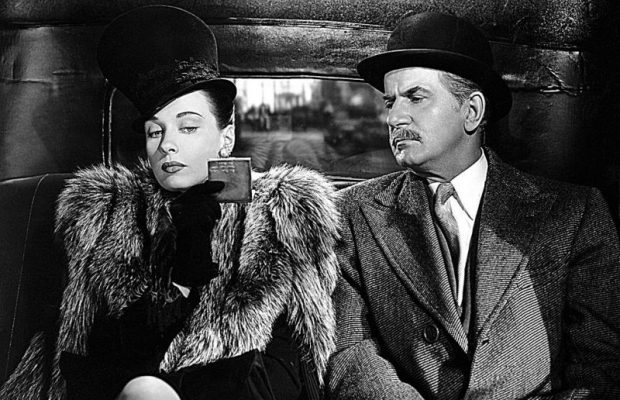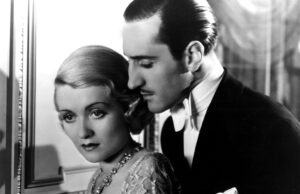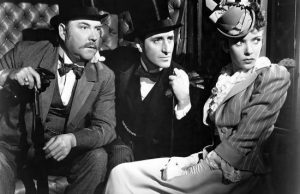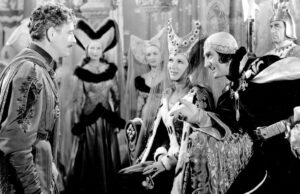Dressed to Kill (1946)

Toronto Film Society presented Dressed to Kill (1946) on Monday, August 14, 2017 in a double bill with Leave Her to Heaven as part of the Season 70 Summer Series, Programme 5.
Production Company: Universal. Producer and Director: Roy William Neill. Screenplay: Leonard Lee, based on a story by Sir Arthur Conan Doyle and adapted by Frank Gruber. Cinematography: Maury Gertsman. Art Direction: Martin Obzina and Jack Otterson. Gowns: Vera West. Editor: Saul A. Goodkind.
Cast: Basil Rathbone (Sherlock Holmes, Nigel Bruce (Doctor Watson), Patricia Morison Mrs. Hilda Courtney), Edmund Breon (Julian ‘Stinky’ Emery), Frederick Worlock (Colonel Cavanaugh), Carl Harbord (Inspector Hopkins), Patricia Cameron (Evelyn Clifford), Holmes Herbert (Ebenezer Crabtree), Harry Cording (Hamid), Leyland Hodgson (Tour Guide), Mary Gordon (Mrs. Hudson), Ian Wolfe (Commissioner of Scotland Yard).
Dressed to Kill marked the end of the Sherlock Holmes series at Universal. A number of theories have been put forward as to why it was not continued, with most commentators, as well as Rathbone himself in his autobiography, saying that he had become frustrated with being typecast, making it difficult for him to find new parts. However, a more practical reason might have been that after seven years of playing these roles, both Rathbone and Nigel Bruce’s contracts had come to an end. Universal would have been unlikely to substitute another Holmes and Watson after such a long run. They would have also had to hire a new director since Roy William Neill died suddenly of a heart attack in December 1946 at the age of 59 shortly after tonight’s film was released.
Despite this end, and despite all the other work that Rathbone did in films, he never really did escape the yoke of being Sherlock Holmes. In fact, he was doing product-endorsement advertising dressed as Holmes right through the 1950s.
In 1953 Rathbone took Holmes to the stage in a play written by his wife Ouida, putting $110,000 of his own money into the venture and fund-raising among all his contacts, including Adrian Conan Doyle, the youngest son of Sir Conan Doyle. The show closed after only three Broadway performances, having been savaged by the critics. The play, which had a contemporary setting, was leisurely, thoughtful and analytical but performance styles had changed and the actors were hopelessly outdated. With the ending of the war, the world had changed and Holmes’ brand of deduction, rationality and infallibility was, for that moment, unsustainable, although the crime genre itself was far from dead.
Rathbone and Bruce played Holmes and Watson in a long-running radio program during the course of the films series. The series began in 1939, right after the success of their first two films, and continued until 1946, when Rathbone bowed out of the series. Bruce continued in the series until 1947, with Tom Conway, alumnus of the Falcon movie series, playing Sherlock Holmes. The stories were always told in retrospect by Dr. Watson to a visitor to his home.
Although there were numerous film and television adaptations of the Holmes character beginning in 1950, but because the Rathbone-Bruce films were so popular, it was over ten years before any other studio dared to release a Holmes film without Rathbone and Bruce in the leads.
Sourced from England’s Secret Weapon: The wartime films of Sherlock Holmes by Amanda J. Field (2009) and Mystery Movie Series of 1940s Hollywood by Ron Backer (2010)
Introduction by Caren Feldman
Storyline:
Three identical music boxes, made by a prison inmate, are sold to three random collectors at a London auction house. A mysterious woman and her accomplices attempt to recover them using all means possible, including murder. Why? Enter Sherlock Holmes.
Fun Facts:
- Visiting the Universal commissary for her lunch whilst still wearing Hilda Courtney’s cockney disguise, Patricia Morison was sternly ordered by the maître d’ to eat with the rest of the extras at the counter, rather than at the actors’ tables.
- Dressed to Kill is the last of fourteen films based on Arthur Conan Doyle’s fictional consulting detective, Sherlock Holmes, starring Basil Rathbone as Sherlock Holmes and Nigel Bruce as Doctor Watson.
- It was one of several titles in the Sherlock Holmes series whose original copyrights were apparently not renewed and have, thereby, fallen into the public domain. As a result, seriously inferior copies are currently being offered by a number of VHS and DVD dealers who do not have access to the original studio masters.
- During the UCLA Sherlock Holmes Restoration Project (1993-2003), they were unable to find any 35mm elements of the main title for this film. The restored version uses a blow-up from a used 16mm television syndication print, which was dissolved into the proper point. The main title of the restored version shows a decrease in resolution, increased grain, and a reduction in image registration.
- Mention is made by Watson of two stories from the original canon, “A Scandal in Bohemia” and “The Solitary Cyclist”.
- This is the last of four titles in Basil Rathbone’s Holmes films to feature actor Ian Wolfe in a supporting role.
Reviews:
“Music boxes made in prison hold the key to the whereabouts of stolen bank plates, in this lively final entry in the Rathbone Sherlock Holmes series. Also shown in computer-colored version.” – Leonard Maltin
“This is the swan song for the Sherlock Holmes series at Universal. The pipe-smoking sleuth with the green tweed suit and the fedora has enough after 14 such films, and turns down a contract renewal, instead returning to the stage (starring in The Heiress) and making other kinds of movies, such as swashbucklers. This is another enjoyable, well-paced and -acted mystery thriller in the series, with the usual pleasant banter between Sherlock Holmes and Dr. Watson. It’s directed with assurance by Roy William Neill, also producer, and is taken from a story by Arthur Conan Doyle. The screenwriters are Hollywood western writer Frank Gruber and Leonard Lee. The plot is not too strong, but the characterizations are perky and it moves along at a nice pace. Holmes must stumble through another couple of murders and get out of a trap in order to hunt down the three villains. Nothing to write home about, but it does follow the successful formula line of the series and should please Holmes fans (which I count myself as one).” – Dennis Schwartz
Notes compiled by David Burgess












Leave a Reply